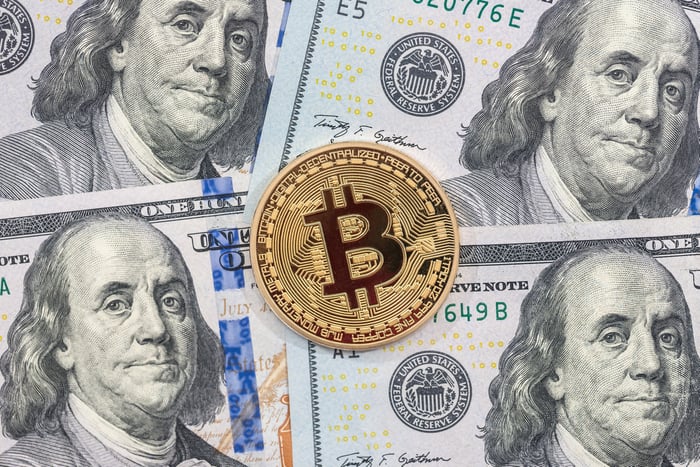There's a really good chance history was made in 2017. At the beginning of the year, the combined value of every single cryptocurrency added up to just $17.7 billion. However, by the end of the year, the aggregate market cap of all virtual currencies had ballooned to around $615 billion. That's an increase in value of nearly 3,400%, and it may very well represent the single greatest year we've ever seen from an asset class.
Here's what drove an incredible year for digital currencies
A number of factors were responsible for sending cryptocurrencies to new heights. The most obvious of these catalysts was the emergence of blockchain technology. Blockchain is the digital, distributed, and decentralized ledger that underlies cryptocurrencies and is responsible for recording all transactions.

Image source: Getty Images.
The buzz on blockchain primarily revolves around its ability to solve a handful of perceived deficiencies with the current way money is transmitted from one party to another. Blockchain offers the ability to settle transactions (especially cross-border transactions) significantly quicker than current payment networks, and do so for a cheaper cost, since there's no third-party involvement. This third party is often a financial institution. Blockchain is also decentralized, meaning there's no single data hub where information is stored. This is done to prevent a cyberattack from cripple a cryptocurrency, as well as to prevent a centralization of authority.
Beyond blockchain, excitement has grown with coins like bitcoin and Litecoin over their potential as a payment facilitator. Bitcoin snagged a handful of brand-name merchants all the way back in 2014, and has since built its merchant base as its legitimacy has grown.
News-driven events have also played a big role. For instance, the announcement that Japan would accept bitcoin as legal tender, as well as the kickoff of futures trading by the CME Group and CBOE Global Markets in December, helped to further validate bitcoin as a being part of new, legitimate asset class. Other examples, include Ripple's blockchain being chosen in a cross-border partnership between American Express and Banco Santander, and Ethereum having a version of its blockchain being tested by 200 organizations in the Enterprise Ethereum Alliance.

Image source: Getty Images.
The hidden cryptocurrency risk you're overlooking
While it was a banner year for cryptocurrencies, these massive gains, and the numerous rumors that have surrounded these virtual coins and blockchains, could set them up for a risk that few folks are talking about right now: class action lawsuits.
Think about this for a moment: practically anytime a traditional equity, such as a publicly traded stock, nosedives following the release of bad news, law firms swarm with the threat of a lawsuit for those investors who've suffered significant losses. The lack of regulation and true legitimacy for cryptocurrencies, along with an endless sea of speculation via tweets and message boards, could open up these foundations, groups, or companies for a host of investor lawsuits in 2018 and beyond.
For instance, Ripple rallied more than 125% last week, briefly surpassing the $100 billion market cap, on rumors that Coinbase, one of the largest cryptocurrency exchanges, would soon be adding Ripple's XRP coin. This unconfirmed rumor essentially added more than $50 billion in market cap at one point. If it doesn't come true and Coinbase chooses not to add the XRP anytime soon, it's possible these rumors could lead to legal action, despite no fault of the Ripple team.
Another hot cryptocurrency last year was Einsteinium and its EMC2 coin. At one point, EMC2 had jumped by more than 262,000% on the expectation of a "big announcement" in December. This announcement turned out to be a change in its mining algorithm that would make it ASIC resistant and graphics card unit (GPU)-friendly. This would allow for improved decentralization, and ensure that anyone who wants an opportunity to mine EMC2 will have a chance.

Image source: Getty Images.
However, rumors had been swirling that this big announcement would be a partnership, and not something as simple as an algorithm change, which caused the EMC2 coin to plunge by 60% in the days that followed. It's caused the Einsteinium Foundation to rethink how it hypes up news releases in the future, and it represents a good example of an event that might warrant class action consideration in the future.
Even Litecoin founder Charlie Lee selling his entire stake in Litecoin has some investors raising their pitchforks in disgust. Lee announced that he sold his position two weeks ago because of a "conflict of interest." Since Lee tweets so much about Litecoin and the direction it'll head next, he deemed himself as having too much influence. This is a perfectly reasonable, and legal, reason to sell his position. Not to mention, Lee wound up donating his sold Litecoin, proving he's a really good guy. Nevertheless, Litecoin has lost about $100 per coin (nearly a third of its value) since Lee sold his position, and it's the type of scenario that law firms look for when seeking class action opportunities.
To be crystal clear, I'm not suggesting that any of the above scenarios will lead to any legal action. However, the excess volatility of late, coupled with the rumor mill that is the cryptocurrency arena, is a matchbox that I believe could set off a wave of lawsuits in the years to come.



